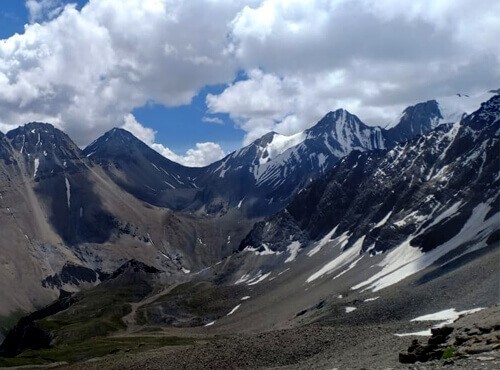Explore the grandeur of Nepal's rugged and remote far west on the Upper Dolpo trek 27 days. Home to gorgeous Phoksundo Lake, Shey Phoksundo National Park, Bon Buddhism, and exclusive snow leopards, the Upper Dolpo boasts trans-Himalayan landscapes. The Upper Dolpo trek is a true adventure camping trek in the Himalayas made for only strong and resilient individuals.
Only a handful of trekkers do the Upper Dolpo trek every year, making the trail empty and tranquil. The region was opened for tourism in 1989, and before that, only some highly privileged expeditions had occurred here. The terrain is similar to the Tibetan plateau. The Upper Dolpo trekking route includes deep valleys, high passes, rushing rivers, giant mountains, ancient monasteries, arid landscapes, and diverse flora and fauna.
Upper Dolpo trekking is very challenging as the tourist infrastructure is almost non-existent here. The region is underdeveloped and quite poor. You have to be self-reliant to do this trek. Likewise, it is also a restricted area in Nepal, so you have to get expensive trekking permits and trek in a group of at least two trekkers. These adversities have kept Upper Dolpo untouched and pristine.
Upper Dolpo has a geographical advantage because it is located in the rain shadow of the Annapurna and Dhaulagiri ranges. Unlike the famous Everest Base Camp and Annapurna Circuit treks, you can do the Upper Dolpo even in the monsoon season (June to August). Following the tropical forests, the trail ascends to the beautiful Phoksundo lake. Explore the flora and fauna of Shey Phoksundo National Park as you trek and cross many high mountain passes.
The cultural heritage of Upper Dolpo
Even though there are no accommodation facilities along the Upper Dolpo trail, you will still trek past many picturesque, remote settlements. The locals are indigenous communities with close ties to Tibet, as many of them are descendants of Tibetans. You will have memorable encounters with the locals.
They welcome trekkers with the kindest smile. The locals of Upper Dolpo are welcoming and humble individuals. Tibetan Buddhism is the predominant religion in Upper Dolpo. The trekking route is dotted with monasteries, stupas, mani stones, chortens, and prayer flags.
The locals highly depend on agriculture, animal husbandry, and trade with Tibet for their livelihood. Shey Gompa, Yangze Gompa, and Namgung Gompa are some of the most significant religious places you will visit during the Upper Dolpo trek. Many families also practice the Bon religion. It is also referred to as Bonpo or Bon Buddhism and predates Tibetan Buddhism.
Landscapes and mountain views along the Upper Dolpo trail
Upper Dolpo trek is famous for jaw-dropping landscapes. From verdant hills and valleys to arid, barren sceneries, the diversity in landscapes is huge on this trek. You will see paddy fields, dense forests, meadows, and hamlets along the trail. Likewise, the trek offers surreal views of Dhaulagiri (8,167 m/26,795 ft), Annapurna (8,091 m/26,545 ft), Kanjiroba (6,883 m/22,582 ft), and Crystal Mountain.
The Upper Dolpo trek is also known as Inner Dolpo Trek. On this 27 days adventure in the remote Himalayas, you will get to witness many lovely sunrises and sunsets. Spend nights under the sky full of stars and share laughter and stories over bonfires with your crew. Far away from the noise of the city, you will dwell in the stillness of the Upper Dolpo.
Join us on the Upper Dolpo trek 2026|2027 trek season. Trek with a team of experts who know how to make the journey smooth and memorable. Get the best Upper Dolpo trek cost with us and freely customize the Upper Dolpo trek itinerary as per your requirements. We, Nepal Nirvana Trails, offer full camping support during the Upper Dolpo trek 27 days and ensure a safe trip.
Attractions of the Upper Dolpo trek
Phoksundo Lake
Phoksundo lake is one of the most breathtaking lakes in Nepal, located at 3,612 meters (11,851 ft) from sea level. The lake is situated in the rain shadow of the Dhaulagiri and Annapurna ranges. Its crystal-clear, deep blue waters against the backdrop of the surrounding arid landscape and the towering Himalayan peak, make the lake look spectacular.
Phoksundo Lake stretches over an area of approximately 4.94 square kilometers and reaches a maximum depth of about 145 meters, making it one of the deepest lakes in Nepal. What makes Phoksundo Lake particularly special is its unusual and changing colors, which can range from deep blue to turquoise or green, depending on the time of day and the angle of sunlight.
*Fact: There is no aquatic life in Phoksundo lake.
Shey Phoksundo National Park
Shey Phoksundo National Park is situated in the rain shadow of the Himalayas, covering a vast area in the Dolpa and Mugu districts of Nepal. It extends from the Tibetan Plateau in the north to the Dhaulagiri and Annapurna mountain ranges in the south. The park is named after two of its most iconic elements Shey, which refers to the Shey Monastery, and Phoksundo, which is the deep blue lake of Phoksundo.
The park encompasses a wide range of ecosystems, from subtropical forests in the lower altitudes to alpine meadows and barren highlands. The Phoksundo river, fed by the stunning Phoksundo Lake, flows through the park. The park's elevation ranges from around 2,130 meters (7,000 feet) to over 6,800 meters (22,300 feet) above sea level.
*Fact: Shey Phoksundo National Park houses rare and elusive wildlife, including the snow leopard, Himalayan blue sheep, musk deer, and various species of pheasants and other birds.
Bon Monastery (Bon Buddhism)
The Bon Monastery is an important center for Bon Buddhism in Ringmo settlement in upper Dolpo. Bon predates the arrival of Buddhism in Tibetan Buddhism. It includes a belief in a multitude of deities and spirits, rituals, and a strong connection to the natural world.
The Bon Monastery in Upper Dolpo plays a crucial role in preserving and continuing the Bon tradition. It serves as an educational and spiritual center for the local community and practitioners from around the world.
Shey Gompa
Shey Gompa is a significant religious and cultural site located in the Upper Dolpo. Shey Gompa is one of the oldest and most revered monasteries in the region. It is believed to have been founded in the 11th century by a Tibetan Buddhist saint and scholar, Lama Nagpopa. The monastery is associated with the ancient Bon religion, as well as Tibetan Buddhism.
Dolpo Yak Caravan
The Dolpo yak caravan is a traditional and iconic method of transportation in this remote area. This unique and fascinating mode of carrying goods and supplies has been used by the indigenous people of Dolpo for centuries. It plays a critical role in the socio-economic and cultural life of the region.
The Dolpo region is characterized by its rugged and challenging terrain, including high mountain passes, deep valleys, and narrow trails. Yaks are well-suited to navigate these conditions, making them invaluable for transporting goods across the region. Yak caravan is a common, intriguing scene for trekkers in Dolpo.
Caravan Movie
"Caravan" is a 1999 American adventure drama film that was shot in the stunning landscapes of the Dolpo region in Nepal. Directed by Eric Valli and co-directed by French filmmaker Michel Debats, the film is known for its breathtaking visuals and portrayal of the unique culture and way of life in Dolpo. The film was nominated for Best Foreign Language Film at the 72nd Academy Awards and won awards at various international film festivals.
The Great Himalayan Trail
The Great Himalayan Trail (GHT) is an extensive network of trekking trails that spans the entire length of the Himalayan mountain range, from the westernmost point in Pakistan to the far eastern regions of Bhutan and India. One of the most iconic and challenging segments of the GHT is the Upper Dolpo route. This route covers the remote and pristine region of Upper Dolpo in Nepal.
Namgung Gompa
Namgung Gompa is a Tibetan Buddhist monastery. The monastery is dedicated to the Nyingma school of Tibetan Buddhism, which is one of the oldest and most traditional schools of Tibetan Buddhism. The monastery houses ancient scripts, religious texts, and valuable religious artifacts that are integral to the religious and cultural life of the region.
The Nepal-Tibet Border: Sumdowa
The Nepal-Tibet border in the Upper Dolpo region, known as Sumdowa or Samling, is a significant geopolitical and geographical boundary that marks the northernmost extent of Nepal and the southern border of the Tibet Autonomous Region of China. Sumdowa is located near the village called Tinje.
The border area has cultural importance for the locals of Dolpo, who are of Tibetan origin and have maintained deep cultural and historical ties with Tibet for centuries. Sumdowa served as a significant trade route where traders from Dolpo would exchange salt, barley, and other goods for Tibetan goods such as tea and clothing.
Be part of the Shey festival in 2026 (Celebrating from 16th to 19th September 2026)
The Shey festival is one of the most significant events in the upper Dolpo. It offers a unique opportunity to experience the vibrant cultural heritage and spiritual traditions of locals. The festival involves various rituals, ceremonies, and traditional practices, including masked dances, cham (ritual dances), chanting of prayers, and offerings.
One of the highlights of this festival is the vibrant masked dance performances by monks, which often depict stories from Tibetan Buddhist mythology and history. It's an occasion for Dolpa families to reunite, exchange greetings, and share their experiences.



